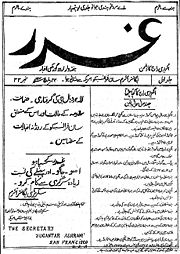
Hindustan Ghadar
Encyclopedia

Ghadar Party
The Ghadar Party was an organization founded by Punjabi Indians, in the United States and Canada with the aim to liberate India from British rule...
. It was published under the auspices of the Yugantar Ashram (Advent of a New Age Ashram
Ashram
Traditionally, an ashram is a spiritual hermitage. Additionally, today the term ashram often denotes a locus of Indian cultural activity such as yoga, music study or religious instruction, the moral equivalent of a studio or dojo....
) in San Francisco. Its purpose was to further the militant nationalist
Revolutionary movement for Indian independence
The Revolutionary movement for Indian independence is often a less-highlighted aspect of the Indian independence movement -- the underground revolutionary factions. The groups believing in armed revolution against the ruling British fall into this category. The revolutionary groups were...
faction of the Indian independence movement
Indian independence movement
The term Indian independence movement encompasses a wide area of political organisations, philosophies, and movements which had the common aim of ending first British East India Company rule, and then British imperial authority, in parts of South Asia...
, especially amongst Indian sepoy
Sepoy
A sepoy was formerly the designation given to an Indian soldier in the service of a European power. In the modern Indian Army, Pakistan Army and Bangladesh Army it remains in use for the rank of private soldier.-Etymology and Historical usage:...
s of the British Indian Army
British Indian Army
The British Indian Army, officially simply the Indian Army, was the principal army of the British Raj in India before the partition of India in 1947...
.
In 1912–1913, the Pacific Coast Hindustan Association was formed by Indian immigrants under the leadership of Har Dayal
Har Dayal
Lala Har Dayal was a Indian nationalist revolutionary who founded the Ghadar Party in America. He was a polymath who turned down a career in the Indian Civil Service...
, with Sohan Singh Bhakna
Sohan Singh Bhakna
Baba Sohan Singh Bhakna was as Indian revolutionary, the founding president of the Ghadar Party, and a leading member of the party involved in the Ghadar Conspiracy of 1915. Tried at the Lahore Conspiracy trial, Sohan Singh served sixteen years of a life sentence for his part in the conspiracy...
as its president, which later came to be called the Ghadar Party
Ghadar Party
The Ghadar Party was an organization founded by Punjabi Indians, in the United States and Canada with the aim to liberate India from British rule...
. With donations raised with the help of the Indian diaspora, especially with the aid of Indian students at the University of California, Berkeley
University of California, Berkeley
The University of California, Berkeley , is a teaching and research university established in 1868 and located in Berkeley, California, USA...
, the party established the Yugantar Ashram at 436 Hill Street where a printing press was set up with the donations. The first Urdu
Urdu
Urdu is a register of the Hindustani language that is identified with Muslims in South Asia. It belongs to the Indo-European family. Urdu is the national language and lingua franca of Pakistan. It is also widely spoken in some regions of India, where it is one of the 22 scheduled languages and an...
edition of Hindustan Ghadar appeared on 1 November 1913, followed by a Punjabi edition 9 December 1913. The issues were first handwritten before being printed on the press. Careful measures were taken to shield the party and its supporters from British intelligence, which included the measure of memorising over a thousand names of the subscribers so that no incriminating evidence could fall into the hands of the British government.
The articles in the paper were initially authored by Har Dayal, with the printing operation run by Kartar Singh Sarabha, then a student of UC, Berkley. Copies of the paper began to be shipped to India with returning Ghadarites and immigrants, and were quickly deemed to be seditious and banned by the British Indian government. Later publications from the Yugantar Ashram included compilations of nationalist compositions and pamphlets, including Ghadar di gunj
Ghadar di gunj
Ghadar di Gunj is a compilaion of nationalist and socialist literature that were produced in the early stages of the Ghadar movement....
, Talwar
Talwar
The talwar is a type of curved sword or sabre from India and modern-day Pakistan...
and other publications which were also banned from British India.

